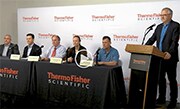Search
BioProbes 76
Featured article
HCA platforms for automated, quantitative analyses: Fueling discovery with high-content imaging and analysis
A wealth of information about a physiological process or pathological condition can be collected by monitoring the localization and abundance of specific proteins using fluorescence imaging. However, quantifying these essential processes through the capture and analysis of fluorescence imagery is both time consuming and laborious. With the advent of high-content analysis platforms that automate image capture and data analysis, these obstacles have been removed, affording researchers both the sample sizes and precise quantitation tools required for truly robust and reproducible research. Among the most cited in scientific articles, high-content analysis (HCA) instruments from Thermo Fisher Scientific—such as the CellInsight CX7 HCA platform—are the go-to choice for researchers requiring the resolution of microscopy with the statistical power inherent in a highly quantitative analysis of a large number of cells.
Read the full article
Download the full issue, BioProbes 76 PDF (2.9 MB)
Fluorophore Selection Guide
Perform multiplex experiments by selecting a combination of fluorescent reagents for detection using interchangeable Invitrogen™ EVOS™ light cubes. These LED cubes are compatible with the Invitrogen™ EVOS FL Auto 2 and EVOS FL Imaging Systems and the Invitrogen™ Countess™ II FL Automated Cell Counter, each of which can be configured in your lab. There are more than 20 light cubes to choose from, and they can easily be transferred between systems.
Fluorescence imaging applications
Fueling discovery with high-content imaging and analysis
Thermo Scientific HCA platforms for automated, quantitative analyses
Appetite for destruction
Studying macroautophagy with Premo fluorescent protein–based sensors
Effectively monitor antibody internalization and trafficking
Improved labeling tools for antibody–drug conjugate screening and characterization
Investigate atherosclerosis with modified low-density lipoproteins
Fluorescently labeled oxidized LDLs and acetylated LDLs
Double vision: Simultaneous visualization of protein and RNA targets
ViewRNA Cell Plus Assay for antibody labeling and in situ hybridization in individual cells
Maximize survival of neurons derived from primary and stem cells
Introducing the Gibco B-27 Plus Neuronal Culture System
Research with antibodies
T lymphocyte immunophenotyping
14-color flow cytometry panel featuring Super Bright antibody conjugates
Boost your stem cell antibody arsenal
Monoclonal antibodies for studying human pluripotent stem cells
The new generation of target-specific protein quantitation
Introducing ProQuantum high-sensitivity immunoassays
Tools for protein analysis
Stunningly easy western blot imaging
Introducing the iBright CL1000 and iBright FL1000 Imaging Systems
Optimize protein integrity and yields during workflows
Broad-spectrum protease and phosphatase inhibitor tablets
Behind the bench blog
Discussing the “Maximum Event Rate” of your flow cytometer
Journal club
Time-resolved analysis of proteome dynamics by TMT-SILAC hyperplexing
An evaluation of dyes for tracking cell proliferation by flow and image cytometry

Molecular Probes School of Fluorescence—Flow Cytometry Basics Module
Do you ever wonder how a flow cytometer works? Need to understand the optical setup of a flow cytometer? Now you can find answers to these questions and more in the Invitrogen Molecular Probes School of Fluorescence—Flow Cytometry Basics module, available online. The Flow Cytometry Basics module is designed to help you understand the fundamentals. This online content covers the three main components of a flow cytometer: fluidics, optics, and electronics, and was written by the bench scientists who created the Molecular Probes Handbook.
Learn more about the Flow Cytometry Basics module at the Molecular Probes School of Fluorescence

Antibody reproducibility standards: A panel discussion with key scientific leaders
Antibody reproducibility and antibody validation* are two significant challenges facing scientific researchers today. Thermo Fisher Scientific recently hosted a roundtable panel discussion in which members from the International Working Group on Antibody Validation (IWGAV), others from the research community, and key Thermo Fisher Scientific personnel participated in a dialogue about antibody validation standards and practices. These researchers addressed the antibody crisis with recommendations to develop standards that ensure proper characterization and consistency for antibodies in the laboratory. Learn more about how Thermo Fisher Scientific is validating antibodies for both functional application and specificity verification.
* The use or any variation of the word “validation” refers only to research use antibodies that were subject to functional testing to confirm that the antibody can be used with the research techniques indicated. It does not ensure that the product(s) was validated for clinical or diagnostic uses.
Listen to the discussion and watch the video

Download the Immune Cell Guide
Download the newly updated Invitrogen Immune Cell Guide, which includes markers for B cells, T cells, dendritic cells, granulocytes, macrophages, and stem cells, just to name a few. Human and mouse antigens and cluster of differentiation (CD) and non-CD antigens are listed in this useful resource.
Visit the Antibodies for Flow Cytometry landing page and download a digital copy of the Immune Cell Guide

Protein Assay Technical Handbook now available
The 60-page Protein Assay Technical Handbook from Thermo Fisher Scientific provides strategies to help you optimize your protein quantitation results. Select your assay method of choice based on assay time, sensitivity, compatibility, standard curve linearity, and protein-to-protein variation. Learn about tools and resources to help choose the right quantitation assays for your research, ensuring more accurate downstream results.
Download a digital copy of the Protein Assay Technical Handbook
不可转售。Super Bright聚合物染料由Becton, Dickinson and Company授权销售。
仅供科研使用,不可用于诊断目的。

